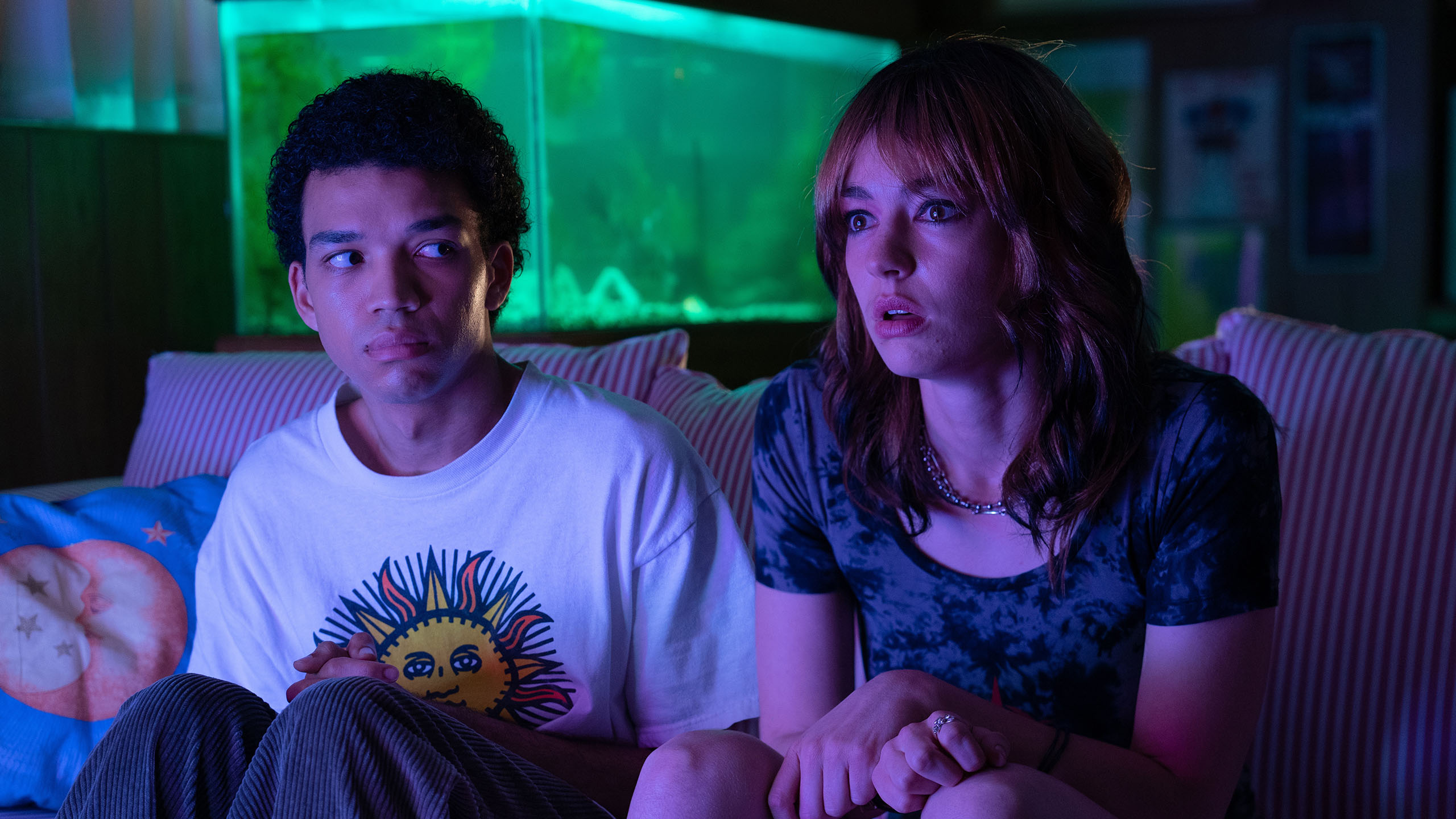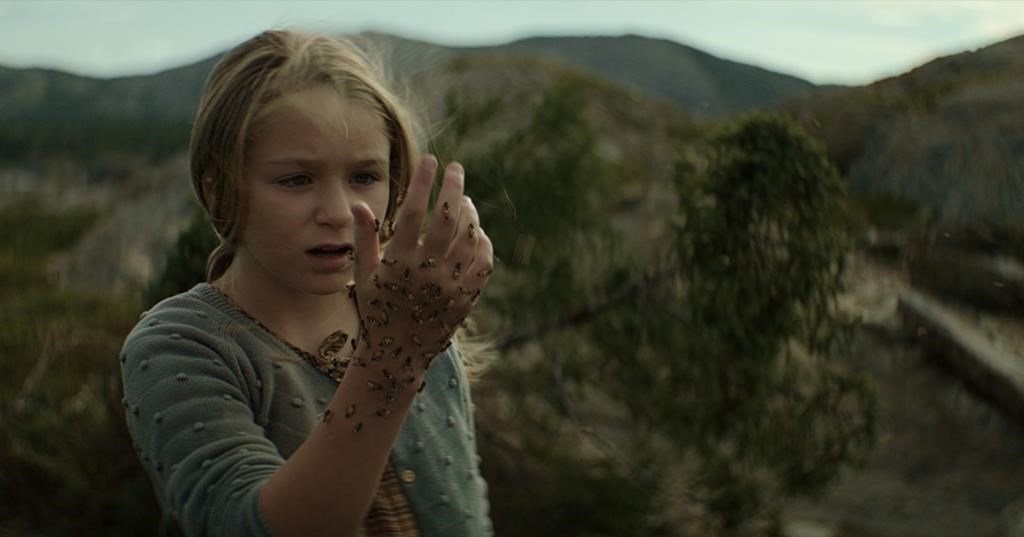Reviews
‘I Saw the TV Glow’ Sundance Review – A Personal Portrait of Dysphoria and Surreal Horror

Writer/Director Jane Schoenbrun’s feature debut, We’re All Going to the World’s Fair, captured the isolating nature of online culture via creepypasta horror through non-narrative, visual storytelling. Schoenbrun continues that core theme of dysphoria in their sophomore effort, I Saw the TV Glow, now armed with a bigger budget that allows the filmmaker to get even more personal while evolving their voice and visual style to an intoxicating degree. I Saw the TV Glow offers a layered and authentic portrait of identity, wrapped in ’90s nostalgia and surreal imagery that embeds itself deep into your psyche.
I Saw the TV Glow charts the life of Owen (Justice Smith) over multiple decades, initially introduced as an early teen (Ian Foreman) in 1996. Owen is a dysphoric and friendless outcast until he bumps into a slightly older student and fellow outcast, Maddy (Brigette Lundy-Paine), at his high school. The pair quickly bond over the young adult supernatural series “The Pink Opaque,” which follows Tara (Lindsey Jordan) and Isabel (Helena Howard) as they fight monsters of the week with their psychic bond, a clear cross between “Buffy the Vampire Slayer” and “Are You Afraid of the Dark?”
The anthology horror series takes over their lives, becoming an obsessive solace from their turbulent home lives. That’s complicated by Owen’s strict dad (an unrecognizable Fred Durst) and distracted, ailing mom (Danielle Deadwyler). As Owen and Maddy struggle to find their place in the world and their identity, “The Pink Opaque” begins to blur the lines of reality.
While not as narratively challenging as Schoenbrun’s debut, I Saw the TV Glow operates on emotion and visual storytelling over a conventional narrative. It heightens the effectiveness of the eerie, potent imagery that pervades Owen’s life, and it showcases Shoenbrun’s incredible eye for framing and composition. The baddies from “The Pink Opaque” bleed over into the real world like a lucid nightmare. Schoenbrun utilizes a variety of techniques, textures, and influences to capture the fictional series’ monsters here, from a Georges Méliès by way of Smashing Pumpkins stop-motion moon villain, Mr. Melancholy, to a nightmarish ice cream truck engulfed in vibrant neon smoke.
It’s a ’90s kid fevered dream of a movie. It’s a familiar yet distant realm where Fruitopia vending machines fill the school cafeteria. Where familiar ’90s pop culture faces like Durst and Buffy alum Amber Benson, briefly appearing as another student’s mom, appear to capture the decade’s vibe further. Where the crackling haze of VHS seeps over on screen, not just with the tapes that Maddy dutifully makes for Owen but also in the villains who escape from their fictional realm. It not only creates a specificity for Schoenbrun’s deeply personal examination but a relatable touchstone of youth- a period where we often form our identities based on our pop culture obsessions and cling to them like lifeboats in tempestuous waters.
Through Owen and Maddy, Schoenbrun fearlessly gets even more personal. Maddy, whose rigid body language matches gritted, angry bursts of speech and eye contact avoidance, longs to escape the oppressive suburbs. Owen’s inner struggles are even more complicated as an asexual trapped for decades by societal expectations and paralyzing fear from taking the next step toward self-actualization. Smith nails Owen’s dissociative persona, a detached loner who buries their true self so deeply as they drift through a surreal world. But it’s Lundy-Paine’s raw turn as Maddy that nearly steals the film, delivering a soul-baring performance. Their glimpses of vulnerability are heartrending, compounded by the pleading monologues delivered with such poignant authenticity and direct eye contact, a rarity for Maddy that devastates.
Schoenbrun delivers a singular vision of arthouse horror that entrances for its fevered dream style and insanely cool imagery. I Saw the TV Glow is relatable for any ’90s kid who ever felt like an outsider whose closest friends were the ones found on TV. There’s something rare and special about a filmmaker so willing to get this personal and to do so with such a confident grasp of visual storytelling. More than just an assured piece of arthouse horror surrealism, it’s a stunning and bittersweet reminder that you’re not alone, fictional friends or otherwise.
I Saw the TV Glow premiered at the Sundance Film Festival. Release date TBA, expected to arrive in 2024 from A24.


Reviews
‘The King Tide’: An Island Town Rots with Moral Decay in Canadian Folk Horror Fable [Review]

The opening scenes of director Christian Sparkes’ The King Tide set an ominous tone: a powerful storm takes down the power lines of a small island town as a pregnant woman loses her child while her dementia-suffering mother sits nearby. In the morning, as the town takes stock of the damage and the power is restored, a surprising discovery is found in an overturned boat in the harbour: a baby girl…with the ability to heal.
Writers Albert Shin and William Woods, working from a story by Kevin Coughlin and Ryan Grassby, treat the story as something of a morality tale mixed with a fable. Following the cold open, the action jumps ahead 10 years at a point when the unnamed island (the film was shot in Newfoundland, Canada) is thriving. The fishing is bountiful, the islanders are self-sufficient and have cut ties with the mainland, and most everyone is happy.
As characters are prone to saying, it’s all thanks to Isla (Alix West Lefler), the miracle baby who has grown up worshipped by the islanders. While Mayor Bobby Bentham (Clayne Crawford) and his wife Grace (Lara Jean Chorostecki) endeavor to raise Isla like any other little girl, the reality is that the island’s entire ecosystem revolves around her miraculous powers. It is only because of Isla that they survive; every aspect of their lives – from medicine to food – relies on her.
Each day the citizens line up for their allotted time with the young girl – be it to stave off breast cancer, like Charlotte (Kathryn Greenwood), or recover from another night of heavy drinking like former doctor, Beau (Aden Young). There’s even a predetermined schedule for when she will go out on the boats and use her power to lure fish into the nets.

One fateful day, Bobby succumbs to peer pressure and alters Isla’s schedule at the last minute to accompany cod fishermen Marlon (Michael Greyeyes) and Dillon (Ryan McDonald). A childish game with fatal consequences is played, but with Isla indisposed, a young boy, who would have otherwise been fine, dies. And while the rest of the community grieves, it is Isla who is completely shaken and, unexpectedly, loses her powers.
Suddenly the entire balance of the island is thrown off. Folks like Grace’s mother, Faye (Frances Fisher), who relied on Isla to keep her dementia at bay, suddenly reckon with mortality, while the food security of the town is called into question. Faye’s late-night “support group” meetings take on an urgent and secretive tone and the townspeople claim ownership of Isla’s time despite Bobby and Beau’s protests that she needs rest to recover from her trauma.
Like the best thrillers, the politics and personalities within the community come into play as morals are compromised and the good of individuals vs the collective is played out in increasingly desperate situations. The King Tide excels because it is interested in exploring the competing motivations of the townspeople, while also resolutely refusing to paint anyone as inherently good or bad. These are desperate people, determined to remain independent and free from outside interference, while protecting their trapped-in-amber way of life.

These developments work because there’s a humanity to the characters and The King Tide wisely relies heavily on its deep bench castoff character actors to drive the conflict. Crawford is the de facto protagonist of the ensemble and he’s also the most straightforward character: Bobby is a good man and a loving father, but he’s no white knight. At several points in the film, his willingness to acquiesce to the demands of the community and retain his power causes events to spiral further out of control.
Even more fascinating are Grace and Faye, two commanding women whose capacity for maternal love is matched – or eclipsed – by their own self-interests. A mid-film discovery about Isla’s power reframes Grace’s priorities, ultimately pitting her against her husband. As a result, Grace is incredibly compelling and frustrating (in a good way) and Chorostecki, who has done great genre work on both Hannibal to Chucky, plays the moral ambiguity exactly right. Grace is a fascinating and flawed human character in a film filled with them.
The same goes for Fisher, who deftly balances Faye’s grandmotherly love for Isla with the needs of the community and, by extension, her own health demands. In the hands of a lesser performer, it would be easy to hate Faye for her actions, but Fisher’s performance perfectly captures the fierce determination and fear that drives the island’s matriarch.
Finally, there’s Aden Young, The King Tide’s secret weapon. The ten-year jump reveals that Beau has undergone the most significant transformation: while everyone else has benefitted from Isla’s powers, her presence has eliminated the need for a doctor. With the clinic effectively shuttered, Beau has become an alcoholic; a shell of his former self with no purpose.
Like Bobby, Beau is the easiest character to root for because of his selfless desire to protect Isla, but Young (renowned for his work with Crawford on Rectify) unlocks the character’s tragic pathos and, in the process, becomes the film’s emotional anchor.

Framing the moral decline of the islanders and anticipating the unexpectedly devastating climax is the natural beauty of Newfoundland. As shot by cinematographer Mike McLaughlin, there’s a steely beauty to the geography, resplendent with rocky cliffs, pounding surf, and gusty bluffs that reinforce the islanders’ isolation.
There’s a fierce pride in their struggle to survive independently, evident in the simple lodgings and the antiquated alarm bell that is rung whenever fishing ships from the mainland stray too close. It’s a chilly, atmospheric calling card for one of the most picturesque provinces in Canada, but it is a perfect complement for the folk horror narrative.
Armed with serene, beautiful cinematography, murky moral developments, and a deep bench of talented character actors, The King Tide is a quiet gem that demands to be seen. It’s one of the year’s best genre films.
The King Tide is in theaters April 26, 2024.














You must be logged in to post a comment.